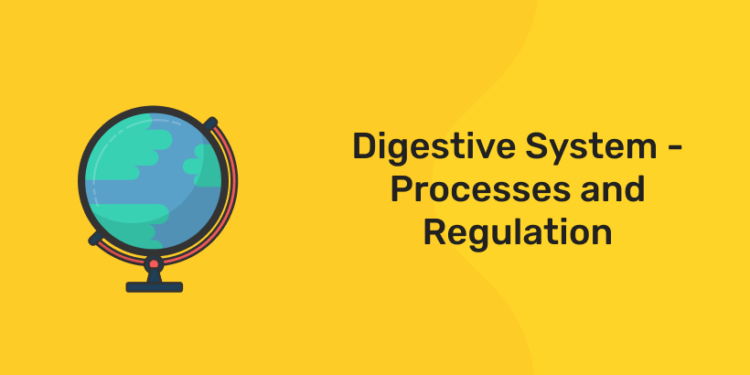Table of Contents
The digestive system ingests and digests food, absorbs released nutrients, and releases out food components that are indigestible. The six activities involved in this process are ingestion, motility, mechanical digestion, chemical digestion, absorption, and defecation. These processes are controlled by neural and hormonal mechanisms. The digestive system uses mechanical and chemical activities to break food down into absorbable substances during its journey through the digestive system.
Digestive System – Organs and its Functions
| SI No | Organ | Major functions | Other functions |
| 1 | Mouth | Ingests food Chews and mixes food Begins chemical breakdown of carbohydrates Moves food into the pharynx Begins breakdown of lipids via lingual lipase |
Moistens and dissolves food, allowing you to taste it
Cleans and lubricates the teeth and oral cavity Has some antimicrobial activity |
| 2 | Pharynx | Propels food from the oral cavity to the esophagus |
Lubricates food and passageways
|
| 3 | Esophagus | Propels food to the stomach |
Lubricates food and passageways
|
| 4 | Stomach | Mixes and churns food with gastric juices to form chyme Begins chemical breakdown of proteins Releases food into the duodenum as chyme Absorbs some fat-soluble substances (for example, alcohol, aspirin) Possesses antimicrobial functions |
Stimulates protein-digesting enzymes
Secretes intrinsic factor required for vitamin B12 absorption in small intestine |
| 5 | Small intestine | Mixes chyme with digestive juices Propels food at a rate slow enough for digestion and absorption Absorbs breakdown products of carbohydrates, proteins, lipids, and nucleic acids, along with vitamins, minerals, and water Performs physical digestion via segmentation |
Provides optimal medium for enzymatic activity
|
| 6 | Accessory organs | Liver: produces bile salts, which emulsify lipids, aiding their digestion and absorption Gallbladder: stores, concentrates, and releases bile Pancreas: produces digestive enzymes and bicarbonate |
Bicarbonate-rich pancreatic juices help neutralize acidic chyme and provide optimal environment for enzymatic activity
|
| 7 | Large intestine | Further breaks down food residues Absorbs most residual water, electrolytes, and vitamins produced by enteric bacteria Propels feces toward rectum Eliminates feces |
Food residue is concentrated and temporarily stored prior to defecation
Mucus eases passage of feces through colon |
Digestive System – Process
1: Who was the first woman President of India?
- The processes of digestion include six activities: ingestion, propulsion, mechanical or physical digestion, chemical digestion, absorption, and defecation
- The first of these processes, ingestion, refers to the entry of food into the alimentary canal through the mouth
- There, the food is chewed and mixed with saliva, which contains enzymes that begin breaking down the carbohydrates in the food plus some lipid digestion via lingual lipase
- Chewing increases the surface area of the food and allows an appropriately sized bolus to be produced.
- Food leaves the mouth when the tongue and pharyngeal muscles propel it into the esophagus
- The act of swallowing, the last voluntary act until defecation, is an example of propulsion, which refers to the movement of food through the digestive tract
- It includes both the voluntary process of swallowing and the involuntary process of peristalsis.
- Peristalsis consists of sequential, alternating waves of contraction and relaxation of alimentary wall smooth muscles, which act to propel food along
- These waves also play a role in mixing food with digestive juices
- Peristalsis is so powerful that foods and liquids you swallow enter your stomach even if you are standing on your head.
- These contractions isolate small sections of the intestine, moving their contents back and forth while continuously subdividing, breaking up, and mixing the contents.
- By moving food back and forth in the intestinal lumen, segmentation mixes food with digestive juices and facilitates absorption.
- In chemical digestion, starting in the mouth, digestive secretions break down complex food molecules into their chemical building blocks (for example, proteins into separate amino acids)
- These secretions vary in composition, but typically contain water, various enzymes, acids, and salts
- The process is completed in the small intestine.
- Food that has been broken down is of no value to the body unless it enters the bloodstream and its nutrients are put to work
- This occurs through the process of absorption, which takes place primarily within the small intestine
- There, most nutrients are absorbed from the lumen of the alimentary canal into the bloodstream through the epithelial cells that make up the mucosa
- Lipids are absorbed into lacteals and are transported via the lymphatic vessels to the bloodstream
Digestive System – Regulation
- Neural and endocrine regulatory mechanisms work to maintain the optimal conditions in the lumen needed for digestion and absorption
- These regulatory mechanisms, which stimulate digestive activity through mechanical and chemical activity, are controlled both extrinsically and intrinsically.
Neural Controls
- The walls of the alimentary canal contain a variety of sensors that help regulate digestive functions.
- These include mechanoreceptors, chemoreceptors, and osmoreceptors, which are capable of detecting mechanical, chemical, and osmotic stimuli, respectively.
- For example, these receptors can sense when the presence of food has caused the stomach to expand, whether food particles have been sufficiently broken down, how much liquid is present, and the type of nutrients in the food (lipids, carbohydrates, and/or proteins).
- Stimulation of these receptors provokes an appropriate reflex that furthers the process of digestion. This may entail sending a message that activates the glands that secrete digestive juices into the lumen, or it may mean the stimulation of muscles within the alimentary canal, thereby activating peristalsis and segmentation that move food along the intestinal tract.
- The walls of the entire alimentary canal are embedded with nerve plexuses that interact with the central nervous system and other nerve plexuses—either within the same digestive organ or in different ones.
- These interactions prompt several types of reflexes. Extrinsic nerve plexuses orchestrate long reflexes, which involve the central and autonomic nervous systems and work in response to stimuli from outside the digestive system
- Short reflexes, on the other hand, are orchestrated by intrinsic nerve plexuses within the alimentary canal wall
- These two plexuses and their connections were introduced earlier as the enteric nervous system
- Short reflexes regulate activities in one area of the digestive tract and may coordinate local peristaltic movements and stimulate digestive secretions
- For example, the sight, smell, and taste of food initiate long reflexes that begin with a sensory neuron delivering a signal to the medulla oblongata
- The response to the signal is to stimulate cells in the stomach to begin secreting digestive juices in preparation for incoming food
- In contrast, food that distends the stomach initiates short reflexes that cause cells in the stomach wall to increase their secretion of digestive juices.
Hormonal Controls
- A variety of hormones are involved in the digestive process.
- The main digestive hormone of the stomach is gastrin, which is secreted in response to the presence of food
- Gastrin stimulates the secretion of gastric acid by the parietal cells of the stomach mucosa. Other GI hormones are produced and act upon the gut and its accessory organs
- Hormones produced by the duodenum include secretin, which stimulates a watery secretion of bicarbonate by the pancreas; cholecystokinin (CCK), which stimulates the secretion of pancreatic enzymes and bile from the liver and release of bile from the gallbladder; and gastric inhibitory peptide, which inhibits gastric secretion and slows gastric emptying and motility
- These GI hormones are secreted by specialized epithelial cells, called endocrinocytes, located in the mucosal epithelium of the stomach and small intestine
- These hormones then enter the bloodstream, through which they can reach their target organs.
Download Entri and practice free mock tests and ace your competitive exams
I hope this article was helpful. The key point to clear an exam lies in methodical and planned preparation. If you are a candidate who wants to pursue your dream career and looking for a good start, our Entri app has got it covered for you. Over the last decade, the concept of education has drastically changed, thanks to the internet. Let’s talk about all the positive contributions it has made. Consistency is the key. Be regular and punctual. Set a study pattern, modify it as per your needs and wants. You know yourself better, so plan accordingly. Our team will help you with content and insights related to the topics of your concern. Subscribe to our app today and enrol yourself into various programmes our app offers. Tune in to the app to stay updated regarding various aspects of the subject you are interested in. Feel free to post any queries and doubts in the comment section. We will try our best to reach out. Push away all those self-doubts and negative thoughts. Try to have a clear vision. Ask yourself why you want this. Focus on the good and work hard. There is a saying that goes like this, Get up and set your shoulders to the wheel-how long is life for you? as you have come to this world leave some mark behind or where is the difference between your trees and stones they too come into existence decay and die. Each day is a precious gift bestowed upon us so make it count. Work on yourself. Stop procrastinating. Today is the day, hope for the best. Good luck












